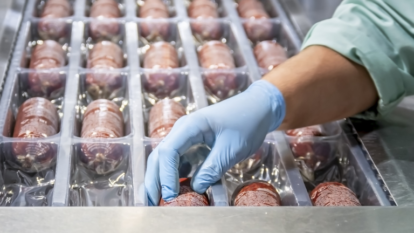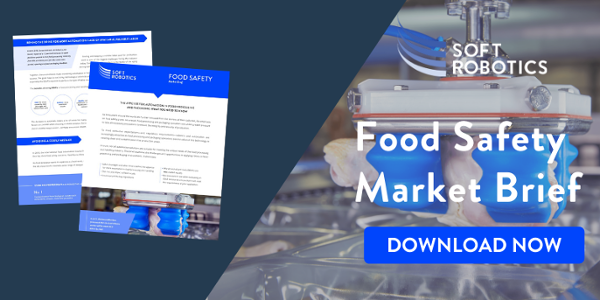
As the Coronavirus continues to invade processing plants and slaughterhouses across the U.S, linking 15,300 confirmed cases to 192 meatpacking plants, factory floors are becoming the breeding ground for the infectious disease. At least 46 plants have closed temporarily since the beginning of the pandemic to help slow the spread of the virus, halting operations for weeks. Feeding America will be one of the greatest challenges in the years to come as companies are unable to find the workers needed to process food. Like most other companies, food industries are looking for ways to improve productivity, and sacrificing food quality for lower cost is not an option. The use of automation will help solve the labor shortage problem, but more importantly, improve food quality.
The jobs are here, but where are the people?
Labor constraints had long hampered the meat industry well before the Covid-19 pandemic. Manufacturers can’t seem to recruit and retain skilled workers to meet the ceaseless pressures to increase productivity, lower costs, and boost revenue. The talent shortage is partly attributed to a negative perception of the food industry. The meat sector is notorious for poor working conditions. Meatpacking workers suffer some of the highest rates of workplace injury and illness in the United States. Common injuries include severed fingers, chemical exposure, and strains from repeating the same tasks over and over. Harsh working conditions, long hours with no breaks combined with low pay make these jobs highly undesirable. Such conditions have proven challenging for companies to recruit and retain talent.
With the untimely Covid-19 pandemic, the labor gap is further widened as thousands of people fall ill to the virus. Meat industry workers are experiencing some of the fastest-growing rates of Covid-19 with a steady rise of confirmed cases at meatpacking plants, food-processing facilities, and farms. Nearly all meatpacking plants have now reopened but outbreaks at processing plants continue to rise. As food plants open and reopen, outbreaks will likely continue to spread, intensifying the labor shortage problem.
Why are food processors not already automating?
Historically, the adoption of robotic automation is relatively slow in the food industry, primarily due to the variability of products. Food products, especially raw meat, tend to be irregular in shape, slimy/slippery, and delicate which makes it difficult for robots to pick up. Add a need for speed, and this task is nearly impossible. When it comes to robots, they’re very good at repeating the same task over and over again. When introduced with products of different sizes, shapes, or structures, that’s where robots show their weakness. Previous automation technologies were unable to handle raw, delicate, and varied food products and because of this, food processors have been unsuccessful in automating food.
Now more than ever, emphasis on worker cleanliness and workplace sanitation is critical to producing clean food products. Food safety has always been at the top of the list for food producers and has been made more difficult with the pandemic. Workers can easily spread pathogens with their hands, even while wearing gloves. Made even more difficult, the shoulder-to-shoulder nature of the work makes cross-contamination more likely to occur as workers process food. The Centers for Disease Control and Prevention reports that approximately 70% of all foodborne disease is caused by the contact of infected individuals. Contamination can easily be transferred to food from workers and preserving hygiene at food plants is not always feasible where thousands of workers are forced to stand right next to one another. A contactless, robotic automation operation will help achieve clean food production.
Why meat producers should automate today.
The labor shortage will continue to be one of the greatest challenges facing food manufacturers which is why the demand for food automation continues to grow. Robots (in the absence of human workers) have many benefits and while one is filling the labor gap, the other (perhaps even more significant) is food safety. Food handlers have direct contact with food, from cutting, deboning, trimming to the packaging process, the final product has been touched by many people. Given how easily it is for humans to spread diseases, the scarier thought is the overwhelming number of confirmed cases among workers at meatpacking plants, food-processing facilities, and farms with a cumulative total of over 16,400 as of May 19. Even with the social distancing directive in place, the concern is on the food handlers who have direct contact with the final product. The removal of human contact from the primary packaging process will help reduce the risk of food contamination.
The importance of food safety cannot be stressed enough, especially during this pandemic, and food producers should consider automating their primary packaging line. With the right end-of-arm tool, food producers can lower the risk of contamination, boost productivity, and ultimately, stay in business. Advances in EOATs has come a long way in addressing these challenges with several options on the market. When it comes to food processing and handling, there are regulations around the world that help manufacturers discern what tools and materials are safe for food contact. Our gripper technology complies with multiple food regulations, including EC 1935/2004 and FDA CFR Title 21 along with being built using GMP (Good Manufacturing Practices). This means that our gripper is designed with food safety top of mind. To minimize the risk of spreading pathogens, our grippers are ingress protected, which means our gripper enclosures are protected from the penetration of bacteria and contamination. If you can lower the risk that the EOAT itself is going to be the cause of transferring bacteria, you lower the risk of bacteria being transferred at all. Made of soft fingers, our grippers ensure the delicate, yet secure handling of raw meat – perfect for your primary packaging process.
As the pandemic continues, stay-at-home mandates are keeping millions of people at home and shuttering thousands of businesses, profits are plunging. In some form after the crisis, social distancing may be the best approach to producing clean foods, solving the labor problem with automation. After all, producing clean food is safe for everyone, and we should leave dull, dirty, and dangerous jobs for robots.
Download our Food Safety Market Brief to learn more.

